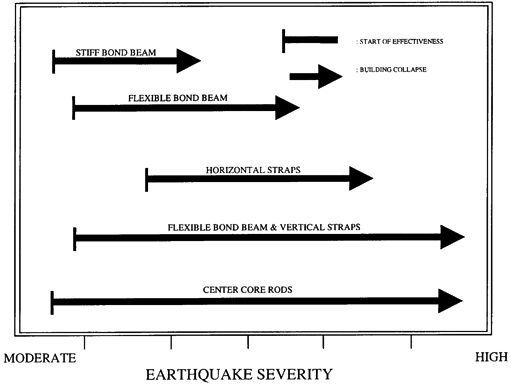SEISMIC STABILIZATION OF HISTORIC ADOBE STRUCTURESWILLIAM S. GINELL, & E. LEROY TOLLES
3 3. SEISMIC STABILITY IMPROVEMENT TECHNIQUESA stability-based retrofit system is intended to prevent wall overturning by limiting the relative displacement between adjacent cracked wall segments and by improving the overall structural continuity of the building. A key feature of this concept is that movement across cracks and rocking should not be prevented but should be restrained so that seismic energy can be dissipated in rocking and as friction at the cracked interfaces. If a retrofitting measure is too strong or too stiff, failure of the structurally weak adobe will occur adjacent to the retrofit. To validate the stability-based retrofit concept, several restraint techniques have been studied and their effectiveness evaluated during shaking table tests of scale model adobe structures. The retrofit measures tested are listed in table 2 for models without roofs. These techniques were also applied to models with a roof, gable end walls, and an attic structure. Partial wood diaphragms and dowels that connected the walls and roof to improve continuity were also tested.
The applicability of each of the retrofitting measures can vary depending on the relative severity of the earthquake, as illustrated schematically in figure 2. A stiff bond beam may have an effect on elastic performance but may be so stiff that the connection between the bond beam and the adobe fails during moderate ground motions. This relationship is especially true when there is no positive connection between the bond beam and the adobe. A more flexible bond beam that is well anchored to the walls may have negligible effects on the elastic behavior but is more than stiff enough to have a substantial effect on the postelastic performance.
The walls must be cracked and begin to move before flexible, horizontal straps become effective. After cracking has developed, these straps can greatly decrease the risk of collapse by providing some restraint against excessive out-of-plane movements and by providing continuity between cracked sections of the walls. Vertical straps and a flexible bond beam do not change the elastic behavior or the behavior when damage is small, but during severe earthquakes, they can greatly reduce the relative displacements of the cracked wall sections and prevent overturning. |
